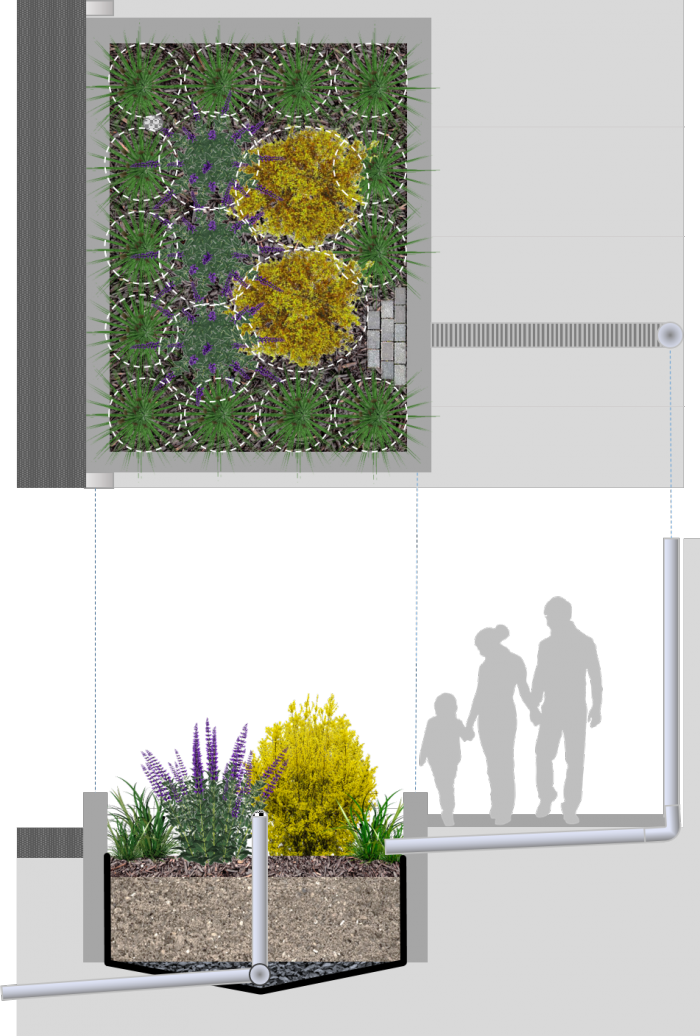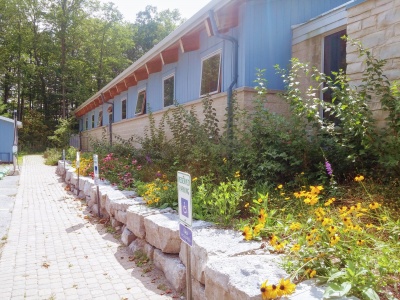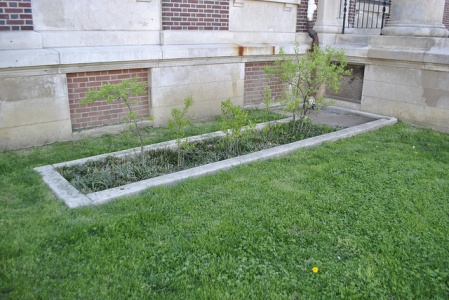Difference between revisions of "Stormwater planters"
Jenny Hill (talk | contribs) m (→Proprietary) |
Jenny Hill (talk | contribs) m |
||
| Line 15: | Line 15: | ||
rect 195 1250 528 1305 [[Reservoir_gravel|Reservoir]] | rect 195 1250 528 1305 [[Reservoir_gravel|Reservoir]] | ||
</imagemap> | </imagemap> | ||
| + | Over subsurface infrastructure, soils prone to subsidence, or pollution hotspots, it may be necessary to prevent all [[infiltration]]. These BMPs can also be squeezed into tight urban spaces, adjacent to buildings and within the usual setbacks required for infiltrating facilities. Stormwater planters can also be used as a means of providing building-integrated LID by capturing a portion of the rainwater from the rooftop. | ||
| − | + | ||
| − | Stormwater planters | + | |
| + | ==Gallery== | ||
| + | {{:Stormwater planters: Gallery}} | ||
==Performance== | ==Performance== | ||
| Line 24: | Line 27: | ||
<ref>Lucke, T., & Nichols, P. W. B. (2015). The pollution removal and stormwater reduction performance of street-side bioretention basins after ten years in operation. Science of The Total Environment, 536, 784–792. https://doi.org/10.1016/J.SCITOTENV.2015.07.142</ref> | <ref>Lucke, T., & Nichols, P. W. B. (2015). The pollution removal and stormwater reduction performance of street-side bioretention basins after ten years in operation. Science of The Total Environment, 536, 784–792. https://doi.org/10.1016/J.SCITOTENV.2015.07.142</ref> | ||
<ref>Macnamara, J.; Derry, C. Pollution Removal Performance of Laboratory Simulations of Sydney’s Street Stormwater Biofilters. Water 2017, 9, 907. doi:10.3390/w9110907</ref> | <ref>Macnamara, J.; Derry, C. Pollution Removal Performance of Laboratory Simulations of Sydney’s Street Stormwater Biofilters. Water 2017, 9, 907. doi:10.3390/w9110907</ref> | ||
| − | |||
| − | |||
| − | |||
| − | |||
==See Also== | ==See Also== | ||
Revision as of 01:07, 9 March 2018
Over subsurface infrastructure, soils prone to subsidence, or pollution hotspots, it may be necessary to prevent all infiltration. These BMPs can also be squeezed into tight urban spaces, adjacent to buildings and within the usual setbacks required for infiltrating facilities. Stormwater planters can also be used as a means of providing building-integrated LID by capturing a portion of the rainwater from the rooftop.
Gallery[edit]
Stormwater planters are ideal for situating alongside buildings to capture rainwater from roof runoff. LSRCA headquarters, 2017.
Stormwater planter, treating downspout runoff, at Waterview Rec Center, Philidelphia
Photo credit: PWDRain garden, Illick Hall, SUNY College of Environmental Science and Forestry, Syracuse, NY
Photo credit: DASonnenfeld
Performance[edit]
This performance related section is due to be updated throughout 2018 as STEP perform a literature review of all common LID performance metrics. Water quality [1] [2] [3]
See Also[edit]
Proprietary links[edit]
A number of precast modules exist to contain treatment media. As many of these systems are enclosed water balance calculations may be erroneous where evapotranspiration is constrained.
In our effort to make this guide as functional as possible, we have decided to include proprietary systems and links to manufacturers websites.
Inclusion of such links does not constitute endorsement by the Sustainable Technologies Evaluation Program.
Lists are ordered alphabetically; link updates are welcomed using the form below.
- ↑ Macnamara, J.; Derry, C. Pollution Removal Performance of Laboratory Simulations of Sydney’s Street Stormwater Biofilters. Water 2017, 9, 907.;doi:10.3390/w9110907
- ↑ Lucke, T., & Nichols, P. W. B. (2015). The pollution removal and stormwater reduction performance of street-side bioretention basins after ten years in operation. Science of The Total Environment, 536, 784–792. https://doi.org/10.1016/J.SCITOTENV.2015.07.142
- ↑ Macnamara, J.; Derry, C. Pollution Removal Performance of Laboratory Simulations of Sydney’s Street Stormwater Biofilters. Water 2017, 9, 907. doi:10.3390/w9110907



